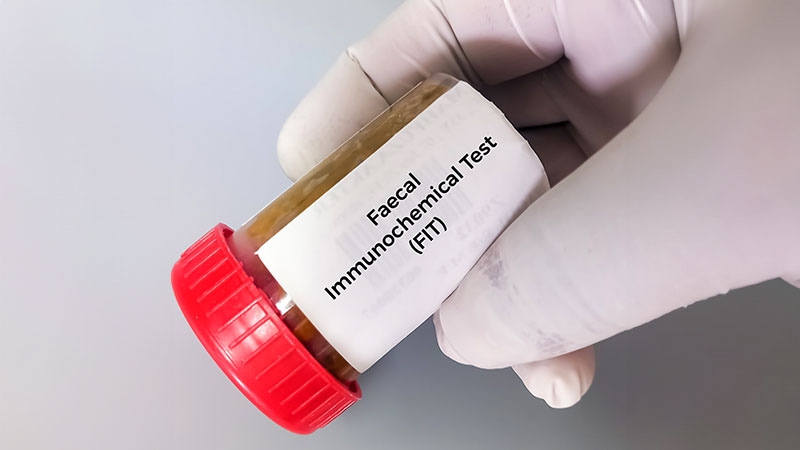insight - Medical diagnostics - # Endoscopist Performance and Colonoscopy Outcomes Following Positive Stool Tests
Endoscopist Quality Significantly Impacts Colonoscopy Outcomes After Positive Stool Tests
Core Concepts
Higher endoscopist polyp detection rates are significantly associated with fewer negative colonoscopies after positive stool tests, suggesting the need for new detection benchmarks.
Abstract
The study evaluated the relationship between endoscopist quality, measured by adenoma detection rate (ADR) and clinically significant serrated polyp detection rate (CSSDR), and the frequency of "false-negative" colonoscopies following positive stool tests (multitarget stool DNA (mt-sDNA) test and fecal immunochemical test (FIT)).
Key findings:
Negative colonoscopies were significantly less common among endoscopists with higher ADR and CSSDR, particularly in the top two quartiles.
After a positive mt-sDNA test, the rate of detection of any adenoma was 62.8% for endoscopists in the top quartile vs 48.7% in the lowest quartile. For CSSDR, detection rates were 66.7% in the top quartile vs 46.9% in the lowest quartile.
Similar results were observed after a positive FIT test. Detection of any adenoma was 63.3% in the top quartile vs 35.8% in the lowest quartile. For CSSDR, detection rates were 54.6% in the top quartile vs 37.3% in the lowest quartile.
Significant differences were also observed in the detection of any sessile serrated lesion (SSL), with higher detection rates in the top quartile than in the lowest quartile.
Based on the findings, the researchers proposed new benchmarks for endoscopist performance following positive stool tests.
Endoscopist Quality Matters After Positive Stool Test
Stats
After a positive mt-sDNA test, the rate of detection of any adenoma was 62.8% for endoscopists in the top quartile vs 48.7% in the lowest quartile.
For CSSDR after a positive mt-sDNA test, detection rates were 66.7% in the top quartile vs 46.9% in the lowest quartile.
After a positive FIT test, detection of any adenoma was 63.3% in the top quartile vs 35.8% in the lowest quartile.
For CSSDR after a positive FIT test, detection rates were 54.6% in the top quartile vs 37.3% in the lowest quartile.
Quotes
"benchmarks of at least 40% (with 60% aspirational detection) for adenoma detection following positive mt-sDNA or FIT, benchmarks of 20% (with 30% aspirational detection) for sessile serrated lesions detection following positive mt-sDNA, and a benchmark of 15% for serrated polyp detection following a positive FIT."
Key Insights Distilled From
by Megan Brooks at www.medscape.com 05-14-2024
https://www.medscape.com/viewarticle/endoscopist-quality-matters-after-positive-stool-test-2024a100093u
Deeper Inquiries
How can the proposed benchmarks be effectively implemented and monitored to improve endoscopist performance and patient outcomes?
The proposed benchmarks for adenoma detection rate (ADR) and clinically significant serrated polyp detection rate (CSSDR) can be effectively implemented and monitored through several strategies. Firstly, training programs can be developed to educate endoscopists on the importance of these benchmarks and provide them with the necessary skills to meet the detection targets. Regular audits and feedback sessions can be conducted to track endoscopist performance against the benchmarks and identify areas for improvement. Utilizing technology such as computer-aided detection systems can also aid in enhancing polyp detection rates and adherence to the benchmarks. Continuous monitoring and feedback mechanisms will be crucial in ensuring that endoscopists maintain high-quality performance and ultimately improve patient outcomes.
What are the potential barriers to adopting these new benchmarks, and how can they be addressed?
There are several potential barriers to adopting the new benchmarks for endoscopist performance. Resistance to change and lack of awareness about the importance of ADR and CSSDR benchmarks may hinder their adoption. Endoscopists may also face challenges in meeting the benchmarks due to variations in patient populations, procedural techniques, and equipment quality. To address these barriers, comprehensive educational programs should be implemented to raise awareness about the benchmarks and their impact on patient outcomes. Providing support and resources for endoscopists to improve their skills and techniques, such as additional training opportunities and access to advanced technology, can help overcome barriers to meeting the benchmarks. Collaboration between healthcare institutions, professional societies, and policymakers is essential to create a supportive environment for implementing and sustaining the new benchmarks.
What other factors, beyond endoscopist quality, may contribute to the rate of false-negative colonoscopies following positive stool tests, and how can those be addressed?
Beyond endoscopist quality, several other factors may contribute to the rate of false-negative colonoscopies following positive stool tests. These factors include patient-related variables such as bowel preparation quality, anatomical factors like the presence of difficult-to-detect polyps, and technical aspects such as the type of colonoscopy equipment used. To address these factors, standardized protocols for bowel preparation can be implemented to ensure optimal visualization during colonoscopy. Advanced imaging techniques like chromoendoscopy or virtual chromoendoscopy can be utilized to improve polyp detection rates, especially for serrated lesions that are often missed with conventional white-light colonoscopy. Quality assurance programs that focus on equipment maintenance and calibration can also help reduce the risk of false-negative colonoscopies. Multidisciplinary collaboration involving gastroenterologists, endoscopists, pathologists, and other healthcare professionals is essential to address these factors comprehensively and enhance the accuracy of colonoscopy following positive stool tests.
0
